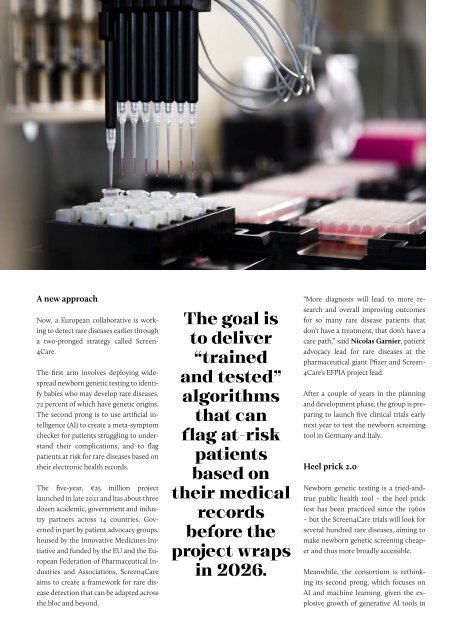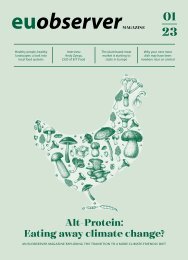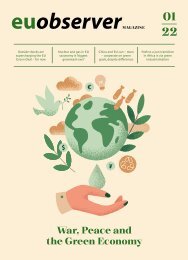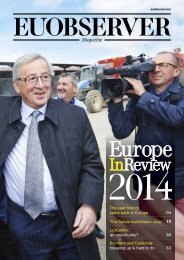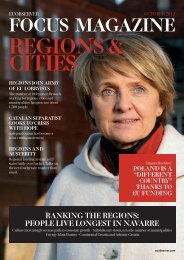Health in a post-pandemic EU
As this magazine goes to press, the World Health Organisation has registered just shy of seven million global deaths due to COVID-19. It also has registered over 13.5 billion doses of vaccines administered. When it comes to health, it’s truly an extraordinary period to be alive. And to stay alive, if all works out as it seems to be doing.
As this magazine goes to press, the World Health Organisation has registered just shy of seven million global deaths due to COVID-19. It also has registered over 13.5 billion doses of vaccines administered. When it comes to health, it’s truly an extraordinary period to be alive. And to stay alive, if all works out as it seems to be doing.
You also want an ePaper? Increase the reach of your titles
YUMPU automatically turns print PDFs into web optimized ePapers that Google loves.
HEALTH IN A POST-PANDEMIC <strong>EU</strong><br />
More diagnosis will lead to<br />
more research and overall<br />
improv<strong>in</strong>g outcomes for so<br />
many rare disease patients that<br />
don’t have a treatment, that<br />
don’t have a care path<br />
Nicolas Garnier<br />
A new approach<br />
Now, a European collaborative is work<strong>in</strong>g<br />
to detect rare diseases earlier through<br />
a two-pronged strategy called Screen-<br />
4Care.<br />
The first arm <strong>in</strong>volves deploy<strong>in</strong>g widespread<br />
newborn genetic test<strong>in</strong>g to identify<br />
babies who may develop rare diseases,<br />
72 percent of which have genetic orig<strong>in</strong>s.<br />
The second prong is to use artificial <strong>in</strong>telligence<br />
(AI) to create a meta-symptom<br />
checker for patients struggl<strong>in</strong>g to understand<br />
their complications, and to flag<br />
patients at risk for rare diseases based on<br />
their electronic health records.<br />
The five-year, €25 million project<br />
launched <strong>in</strong> late 2021 and has about three<br />
dozen academic, government and <strong>in</strong>dustry<br />
partners across 14 countries. Governed<br />
<strong>in</strong> part by patient advocacy groups,<br />
housed by the Innovative Medic<strong>in</strong>es Initiative<br />
and funded by the <strong>EU</strong> and the European<br />
Federation of Pharmaceutical Industries<br />
and Associations, Screen4Care<br />
aims to create a framework for rare disease<br />
detection that can be adapted across<br />
the bloc and beyond.<br />
The goal is<br />
to deliver<br />
“tra<strong>in</strong>ed<br />
and tested”<br />
algorithms<br />
that can<br />
flag at-risk<br />
patients<br />
based on<br />
their medical<br />
records<br />
before the<br />
project wraps<br />
<strong>in</strong> 2026.<br />
“More diagnosis will lead to more research<br />
and overall improv<strong>in</strong>g outcomes<br />
for so many rare disease patients that<br />
don’t have a treatment, that don’t have a<br />
care path,” said Nicolas Garnier, patient<br />
advocacy lead for rare diseases at the<br />
pharmaceutical giant Pfizer and Screen-<br />
4Care’s EFPIA project lead.<br />
After a couple of years <strong>in</strong> the plann<strong>in</strong>g<br />
and development phase, the group is prepar<strong>in</strong>g<br />
to launch five cl<strong>in</strong>ical trials early<br />
next year to test the newborn screen<strong>in</strong>g<br />
tool <strong>in</strong> Germany and Italy.<br />
Heel prick 2.0<br />
Newborn genetic test<strong>in</strong>g is a tried-andtrue<br />
public health tool – the heel prick<br />
test has been practiced s<strong>in</strong>ce the 1960s<br />
– but the Screen4Care trials will look for<br />
several hundred rare diseases, aim<strong>in</strong>g to<br />
make newborn genetic screen<strong>in</strong>g cheaper<br />
and thus more broadly accessible.<br />
Meanwhile, the consortium is reth<strong>in</strong>k<strong>in</strong>g<br />
its second prong, which focuses on<br />
AI and mach<strong>in</strong>e learn<strong>in</strong>g, given the explosive<br />
growth of generative AI tools <strong>in</strong><br />
2023. The Screen4Care <strong>in</strong>itiative was <strong>in</strong>itially<br />
dreamt up <strong>in</strong> mid-2019, and Garnier<br />
said he wants to “future-proof” the<br />
AI tools to prevent them from becom<strong>in</strong>g<br />
obsolete as that technology evolves. The<br />
goal is to deliver “tra<strong>in</strong>ed and tested”<br />
algorithms that can flag at-risk patients<br />
based on their medical records before the<br />
project wraps <strong>in</strong> 2026.<br />
At that time, Garnier said the consortium<br />
will present <strong>EU</strong> policymakers with<br />
a list of recommendations to expand on<br />
its work. One key policy area is equity,<br />
given gaps <strong>in</strong> rare disease detection are<br />
stark even with<strong>in</strong> Europe. As of 2022, Italy<br />
screened newborns for more than 45<br />
diseases, for example, while France tested<br />
for fewer than ten and Romania and<br />
Cyprus looked for only two diseases <strong>in</strong><br />
their national programs.<br />
“Even right now, with similar technologies<br />
available across different countries,<br />
the adoption is really different,” Garnier<br />
said.<br />
That’s due largely to public policy. The<br />
logic follows that if a disease isn’t treatable,<br />
don’t screen for it, Garnier said. But<br />
he wants these conditions to be identified<br />
anyway, to better understand the<br />
size of the patient population for specific<br />
rare diseases and to <strong>in</strong>centivise drug<br />
companies to <strong>in</strong>vest <strong>in</strong> research and development<br />
to treat them.<br />
Equitable detection<br />
Over time, regional disparities could<br />
become even more apparent across the<br />
globe. With<strong>in</strong> ten years, Garnier said that<br />
widespread genetic newborn screen<strong>in</strong>g<br />
will likely be commonplace <strong>in</strong> the <strong>EU</strong> and<br />
the U.S., but that some countries could<br />
fall beh<strong>in</strong>d due to a lack of resources.<br />
The Screen4Care program is <strong>in</strong>ternationally<br />
adaptable, Garnier said, but its<br />
long-term success will depend on policy<br />
efforts to prioritise rare disease diagnosis<br />
– the first step toward widespread access<br />
to treatments for the millions of people<br />
globally liv<strong>in</strong>g with rare diseases.<br />
“Science and <strong>in</strong>novation are go<strong>in</strong>g to<br />
move a lot faster than policy – that’s not<br />
new,” Garnier said. “The limit<strong>in</strong>g factor<br />
is really go<strong>in</strong>g to be policy. That will be<br />
the challenge, and that will be the decid<strong>in</strong>g<br />
factor for what rare disease diagnosis<br />
looks like <strong>in</strong> 2033.” •<br />
About<br />
Gaby Galv<strong>in</strong><br />
Gaby Galv<strong>in</strong> is a freelance journalist<br />
based <strong>in</strong> Amsterdam. Her work<br />
has appeared <strong>in</strong> Euronews, U.S.<br />
News & World Report and <strong>Health</strong>care<br />
Brew, among others.<br />
23


